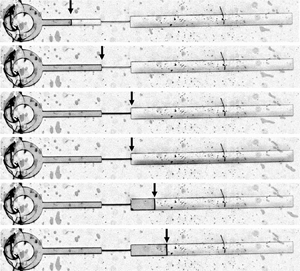Article contents
Intermittent air invasion in pervaporating compliant microchannels
Published online by Cambridge University Press: 16 September 2022
Abstract

We explore air invasion in a dead-end compliant water-filled microchannel containing a constriction. The phenomenon is driven by the pervaporation of the liquid present in the channel through the surrounding medium. The penetration is intermittent, jerky and characterised by a stop-and-go dynamics as the bubble escapes the constriction. We demonstrate that this sequence of arrest and jump of the bubble is due to an elasto-capillary coupling between the air–liquid interface and the elastic medium. When the interface enters the constriction, its curvature increases strongly, leading to a depressurisation within the liquid-filled channel that drives a compression of the channel. As the interface is forced to leave the constriction at a given threshold pressure, due to the ongoing loss of liquid content by pervaporation, the pressure is suddenly released, which gives rise to a rapid propagation of the air bubble away from the constriction, and a restoration of the rest shape of the channel. Combining macroscopic observations and confocal imaging, we present a comprehensive experimental study of this phenomenon. In particular, the effect of the channel geometry on the time of arrest in the constriction and the jump length is investigated. Our novel microfluidic design succeeds in mimicking the role of inter-vessel pits in plants, which transiently stop the propagation of air embolisms during long and severe droughts. It is expected to serve as a building block for further biomimetic studies in more complex leaf-like architectures, in order to recover this universal phenomenon of intermittent propagation reported in real leaves.
- Type
- JFM Papers
- Information
- Copyright
- © The Author(s), 2022. Published by Cambridge University Press
References
Keiser et al. Supplementary Movie 1
Recording of the pervaporation-induced drying dynamics in two channels containing a constriction. The dark line across each channel is a meniscus separating a water-filled region (right part) from an air-filled region (left part). The geometrical dimensions of the channel are: constriction length 1 mm, constriction width 30 µm, exit channel length 5.5 mm, exit channel width 330 µm for the top channel, and 390 µm for the bottom channel.
- 5
- Cited by



